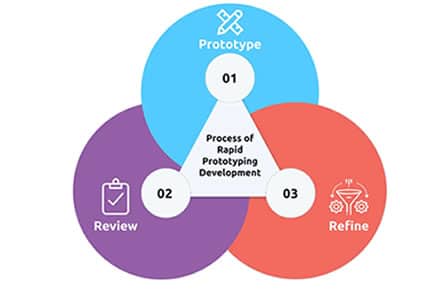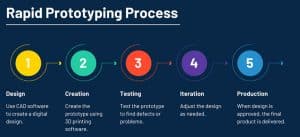
Share Rapid Prototyping Technologies In CNC Manufacturing.

Perhaps, as a manufacturer, you are trying to determine which rapid prototyping technique would work best for your company and your product. Here, we’ll list the most popular techniques and the process each one uses. We will also include the advantages and disadvantages of each technique.
The 4 main types of rapid prototyping are stereo lithography (SLA), selective laser sintering (SLS) or selective laser melting (SLM), and fused deposition modeling (FDM). Each type has its own process and benefits.
The Basic Process
The basic process of rapid prototyping techniques is the use of a CAD file model that is divided by software into a stack of thin slices. With this data a 3D printer adds the chosen material to recreate the original product. This process is an additive process, unlike the traditional subtractive processes of machining1. Each type of rapid prototyping technology uses a version of this basic process. This type of prototyping produces parts more cost efficiently, without the need for special tooling, and with a greater range of design than traditional methods of prototyping.
The basic process of rapid prototyping techniques
Stereo Lithography sla
Selective Laser Sintering
Selective laser sintering, or SLS, was developed from a government program in the mid-80s. Sintering is a process where powdered/granular plastic or metal is joined using pressure and/or heat. This process creates a strong, solid object that is manufacturable. SLS doesn’t require supports as SLA does. This is a major advantage of SLS, as the designer is not limited to certain design requirements. Another advantage is there is no need to make special tools or dies to manufacture the parts, which helps balance the cost of producing the part with SLS. With a CAD file and SLS a part can be produced within a day, making this rapid prototyping technique perfect for producing viable prototypes, parts with complex designs, and single pieces3.
Selective Laser Sintering
Fused Deposition Modeling
As with the previous methods of prototyping, fused deposition modeling, or FDM, was developed in the 80s. This method is the one most people are familiar with. This technique uses a spool of plastic or metal that is distributed through a nozzle in a layering pattern to produce an object. This type of 3D printing is making the process easier and less expensive, with smaller machines and different types of printing materials. Although the nozzle can limit design details, the ability to use more than one type of printing material adds versatility to the design capabilities. While producing large quantities with this process isn’t currently applicable, this type of rapid prototyping technique is good for quickly producing small quantities of parts at an effective cost3.
Fused Deposition Modeling
Selective Laser Melting
Selective laser melting, or SLM, uses a CAD drawing to create an object with printed 2D layers of metal, using both sintering and welding to create a completely dense part. This is a popular rapid prototyping technique because complex designs and internal aspects that reduce weight and increase strength are quickly and efficiently achievable. This rapid prototyping technique is popular in the automotive, medical and aerospace industries3.
Stereo Lithography
Most 3D prototyping techniques started in the 80s when Hideo Koyama created the process of combining a UV light with a photoreactive polymer to create a solid object. Koyama neglected to patent the process, so a man named Charles Hull created a file format for stereolithography and patented the process. Mr. Hull also coined the terms rapid prototyping and 3D printing3.
Stereolithography, or SLA, is a well-known form of 3D printing. SLA requires 3D CAD software to create the object’s geometry and supports needed to add structure to the object (Star). SLA can produce extreme detail and a finished surface (Protosys). Another major benefit of SLA printing is parts can be created quickly, sometimes in less than a day. Drawbacks to SLA printing are that the size of the object is often limited and the process can be expensive. SLA printing is mostly popular for testing aspects of a new design before manufacturing mass amounts3.
Selective Laser Melting
Which Technique is Right for You?
Choosing the right popular rapid prototyping technique(XTJ) depends on what type of component or object you have designed. Which technique will best suit the material, size, complexity, time-frame and design of your product? It is important to understand the advantages and disadvantages of each technique to determine which one to choose.
For instance, SLA has accuracy, detail and a presence in industry. However, it is limited in available materials, needs supports, and needs to be cured after production. SLS, on the other hand, doesn’t require any post curing, has limited need for support structures, and a larger range of material choices. It does require some finishing and changing from different materials can be difficult compared to other rapid prototype techniques. FDM has no need for curing, range of materials, and easier changeover, but loses some advantage in its lack of speed on larger parts, loss of small details, and some requirements for support in certain materials2.
Choosing XTJ , one of the most popular rapid prototyping techniques is easy when you learn the process, advantages and disadvantages of each technique and compare them to the requirements of your prototype design. Your product’s budget, design, materials, size and time restrictions are the blueprints to determining which of the most popular rapid prototyping techniques is best for you.

